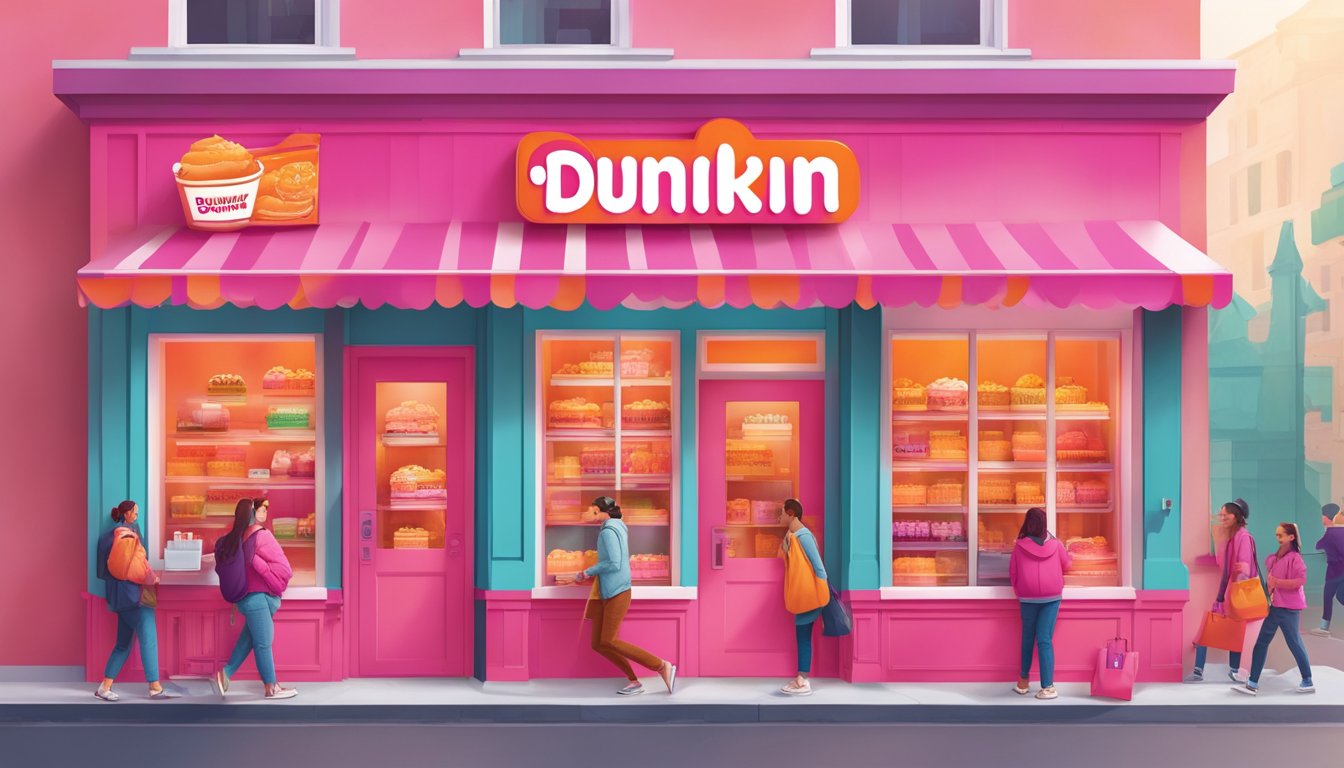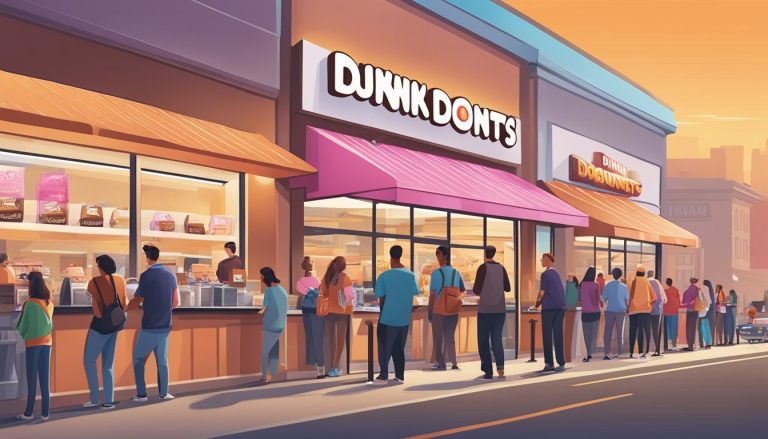Dunkin’s iconic pink and orange branding has become synonymous with the beloved coffee and donut chain. These vibrant hues evoke feelings of warmth, energy, and approachability that resonate deeply with consumers. The psychology behind Dunkin’s color choices taps into our subconscious associations, triggering positive emotions and creating a memorable brand identity.
The pink and orange palette emerged in the 1980s as part of Dunkin’s evolving visual identity. Pink conveys sweetness and friendliness, while orange radiates enthusiasm and vitality. Together, these colors create a perfect balance that appeals to a wide demographic. The bright, candy-like tones also subtly remind customers of the sweet treats awaiting them inside Dunkin’ stores.
By consistently using this color scheme across all touchpoints, Dunkin’ has built strong brand recognition. From storefronts to packaging and advertisements, the pink and orange combination instantly signals the Dunkin’ experience to consumers. This powerful visual cue has played a crucial role in establishing Dunkin’ as a familiar and comforting presence in people’s daily lives.
The Evolution of Dunkin’s Brand Identity
Dunkin’s brand identity has undergone significant transformations since its inception, reflecting changing consumer preferences and market dynamics. The company’s visual elements and naming strategies have played crucial roles in shaping its image over the years.
The Origin of Dunkin’ Donuts and Brand Name
William Rosenberg founded Dunkin’ Donuts in 1950 in Quincy, Massachusetts. The original name emphasized the company’s focus on donuts and coffee. This straightforward approach helped establish Dunkin’ Donuts as a go-to spot for breakfast treats.
The brand quickly gained popularity, expanding through franchising. By 1955, Dunkin’ Donuts had grown to 5 locations. The name “Dunkin’ Donuts” became synonymous with quick, tasty breakfast options.
As the company expanded, it maintained its core identity while adapting to new markets. The brand name remained consistent for decades, building strong recognition among consumers.
Dunkin’ Logo Redesign and Color Palette
Dunkin’s logo has been a key element of its visual identity since 1973. The iconic pink and orange color scheme was introduced at this time, creating a bright and cheerful brand image.
The logo underwent several updates over the years, but maintained its core elements:
- Bold typography
- Pink and orange colors
- Coffee cup icon (in some versions)
In 2018, Dunkin’ unveiled a simplified logo design. This new logo retained the familiar colors but removed the coffee cup icon. The updated design aimed for a cleaner, more modern look while preserving brand recognition.
Rebranding to Dunkin’: Implications for the Brand Image
In January 2019, Dunkin’ Donuts officially rebranded to simply “Dunkin'”. This name change reflected the company’s evolving focus beyond just donuts. The rebranding aimed to position Dunkin’ as a beverage-led, on-the-go brand.
Key aspects of the rebranding:
- Simplified name
- Retained pink and orange color scheme
- New store designs
- Expanded menu offerings
The rebranding strategy sought to appeal to younger consumers and highlight Dunkin’s broader range of products. It also aimed to reinforce the brand’s reputation for speed and convenience.
The Role of William Rosenberg
William Rosenberg played a crucial role in shaping Dunkin’s early brand identity. His vision for quick service and quality products laid the foundation for the company’s success.
Rosenberg’s key contributions:
- Developed the original Dunkin’ Donuts concept
- Introduced franchising, enabling rapid expansion
- Emphasized consistency across locations
- Focused on coffee quality alongside donuts
Rosenberg’s approach to branding and business set the stage for Dunkin’s long-term success. His strategies continue to influence the company’s identity, even as it evolves to meet changing consumer demands.
Psychological Impact of Dunkin’s Branding Elements
Dunkin’s branding elements work together to create a strong psychological impact on consumers. The company’s use of color, typography, and integrated marketing strategies all play crucial roles in shaping brand perception and emotional connections.
Significance of Vibrant Colors in Logo and Packaging
Dunkin’s iconic pink and orange color scheme serves as a powerful visual cue. Pink evokes feelings of sweetness, playfulness, and youthfulness, appealing to a wide demographic. Orange, on the other hand, represents energy, enthusiasm, and warmth.
These vibrant colors create a sense of excitement and positivity around the brand. They help Dunkin stand out in crowded retail environments and make its products easily recognizable on shelves.
The bright color palette also triggers associations with freshness and flavor, subtly influencing consumers’ perceptions of Dunkin’s offerings. This color combination has become so closely tied to the brand that it can evoke thoughts of Dunkin even without the logo present.
Typography and Typeface in Dunkin’s Branding
Dunkin’s typeface plays a significant role in its brand identity. The bold, rounded letters convey a friendly and approachable personality. This typeface has been a consistent element since 1973, creating a sense of familiarity and nostalgia for long-time customers.
The simplicity of the font makes it highly legible, ensuring the brand name is easily read from a distance or at a glance. This clarity is crucial for a fast-paced, on-the-go brand like Dunkin.
In 2018, Dunkin simplified its logo by removing “Donuts” while maintaining the distinctive typeface. This change signaled the brand’s evolution beyond donuts while preserving its recognizable visual identity.
The Integrated Marketing Strategies Enhancing Brand Perception
Dunkin’s integrated marketing strategies reinforce its brand perception across various touchpoints. The company maintains consistency in its visual branding across packaging, store design, advertisements, and digital platforms.
This uniformity helps create a cohesive brand experience, strengthening consumer recognition and recall. Dunkin’s marketing often emphasizes speed and convenience, aligning with its brand positioning as a quick-service beverage and food provider.
The brand also leverages social media to engage with customers, sharing colorful, eye-catching content that reflects its vibrant brand identity. These efforts help Dunkin foster a sense of community and loyalty among its customer base.
Consumer Engagement and Preferences
Dunkin’ adapts its offerings and initiatives to align with evolving consumer preferences and market trends. The brand focuses on menu innovation, customer loyalty, and health-conscious options to maintain its competitive edge.
Menu Innovation and Diversified Offerings
Dunkin’ regularly introduces new menu items to cater to changing consumer tastes. The brand expanded beyond its traditional donuts and coffee to include sandwiches, wraps, and specialty beverages. This diversification appeals to a broader customer base and encourages repeat visits.
Seasonal offerings, like pumpkin-flavored drinks in autumn, create excitement and drive sales. Dunkin’ also collaborates with popular brands for limited-time products, generating buzz and attracting new customers.
The company invests in research and development to stay ahead of coffee market trends. This includes experimenting with cold brew, nitro coffee, and plant-based milk alternatives to meet growing demand for these options.
Customer Experience and Loyalty Initiatives
Dunkin’ prioritizes customer engagement through its DD Perks loyalty program. Members earn points on purchases, redeemable for free beverages. This incentivizes repeat visits and fosters brand loyalty.
The Dunkin’ mobile app enhances convenience with features like mobile ordering and payment. Users can customize orders, skip lines, and access exclusive offers, improving the overall customer experience.
In-store experiences are streamlined with digital menu boards and drive-thru lanes. Some locations feature modern designs with comfortable seating areas, encouraging customers to stay and enjoy their purchases.
Health-Conscious Options and Market Trends
Recognizing the growing demand for healthier choices, Dunkin’ has expanded its menu to include more nutritious options. The brand offers egg white sandwiches, oatmeal, and fruit-based smoothies to appeal to health-conscious consumers.
Dunkin’ has also reduced artificial ingredients in many products and provides calorie information on menu boards. This transparency helps customers make informed decisions about their food and beverage choices.
Plant-based alternatives, such as almond milk and Beyond Meat sausage, cater to vegan and vegetarian consumers. These options align with current market trends and expand Dunkin’s appeal to a wider audience.
Dunkin’s Branding Strategy and Digital Presence
Dunkin’ has implemented a comprehensive branding strategy that spans digital platforms, partnerships, and physical spaces. The company has focused on modernizing its image while maintaining core brand elements.
Embracing Digital Transformation
Dunkin’ has invested heavily in digital initiatives to enhance customer experience. The Dunkin’ mobile app allows for easy ordering and payment, integrating with the DD Perks loyalty program. This digital ecosystem has streamlined operations and personalized marketing efforts.
The brand has also amplified its social media presence, engaging customers across platforms like Instagram, Twitter, and TikTok. These channels showcase new products, run promotions, and foster community engagement.
Dunkin’ has implemented AI-driven menu boards in some locations, optimizing product suggestions based on factors like weather and time of day.
Effective Brand Partnerships and Collaborations
Dunkin’ has strategically partnered with various brands to expand its reach and appeal. Collaborations with companies like Saucony for limited-edition sneakers have generated buzz and reinforced brand loyalty.
The company has also teamed up with food brands like Pop-Tarts and Goldfish to create co-branded products. These partnerships have helped Dunkin’ tap into new markets and demographics.
Celebrity endorsements, such as partnerships with TikTok stars Charli and Dixie D’Amelio, have boosted Dunkin’s visibility among younger consumers.
Store Design and the Physical Manifestation of the Brand
Dunkin’ has revamped its store designs to reflect its updated brand identity. The new concept, called “Next Generation,” features modern decor, digital kiosks, and dedicated mobile order pickup areas.
The iconic pink and orange color scheme remains prominent in store interiors, reinforcing brand recognition. Open layouts and communal seating areas encourage customers to linger and enjoy their purchases.
Drive-thru lanes have been optimized for efficiency, with some locations featuring multiple lanes to reduce wait times. This focus on convenience aligns with Dunkin’s brand promise of speed and accessibility.
Analysis of Dunkin’s Market Position
Dunkin’ holds a significant place in the competitive coffee and quick-service restaurant industry. Its brand recognition, franchise model, and focus on quality coffee drive its market position and expansion efforts.
The Coffee Chain Landscape and Dunkin’s Place
Dunkin’ operates in a crowded coffee chain market dominated by major players like Starbucks and McDonald’s. The brand positions itself as a more accessible and affordable option, appealing to customers seeking quick, quality coffee. Dunkin’s pink and orange branding helps it stand out visually from competitors.
The company’s recent rebranding from “Dunkin’ Donuts” to simply “Dunkin'” reflects its evolution beyond just donuts. This shift aims to emphasize its coffee offerings and broader menu, aligning with changing consumer preferences.
Dunkin’ leverages its strong brand recognition to maintain customer loyalty. The familiar logo and colors create a sense of comfort and reliability for regular customers.
Franchise Model and Global Expansion
Dunkin’ utilizes a franchise-based business model, which has been key to its rapid expansion. This approach allows for faster growth while reducing corporate risk.
The franchise system enables local operators to adapt to regional tastes and preferences. This flexibility has been crucial for Dunkin’s international expansion efforts.
Dunkin’ has a strong presence in the United States and continues to grow globally. The brand has successfully entered markets in Europe, Asia, and the Middle East, adapting its offerings to local palates while maintaining core brand elements.
Competitive Strategies for Quality Coffee
Dunkin’ emphasizes its coffee quality to compete with specialty coffee shops. The brand has invested in improving its coffee sourcing and brewing methods to appeal to more discerning coffee drinkers.
Marketing campaigns often highlight Dunkin’s coffee credentials. These efforts aim to change perceptions of Dunkin’ as primarily a donut shop to a serious coffee destination.
The company has expanded its coffee menu to include espresso-based drinks and cold brew options. This diversification helps Dunkin’ capture a wider range of coffee consumers and compete more directly with coffee-focused chains.
Dunkin’ also focuses on speed of service as a competitive advantage. The brand’s messaging often emphasizes getting quality coffee quickly, appealing to time-pressed customers.




